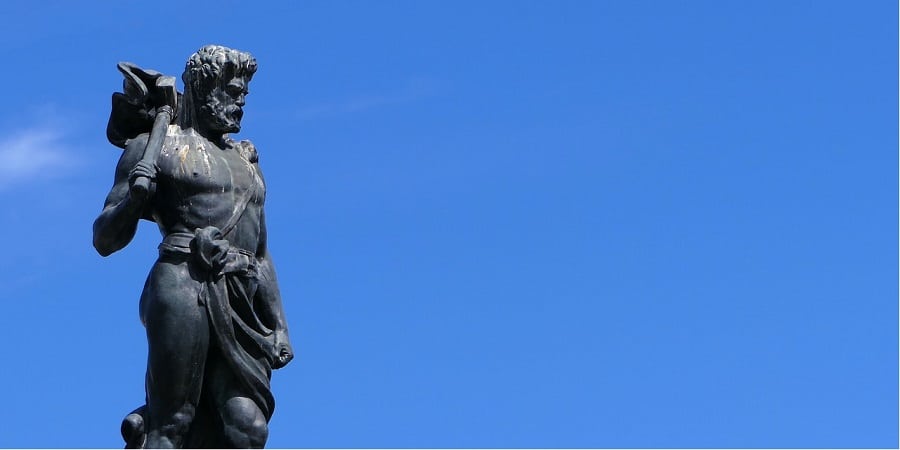There is no more famous god in the Norse pantheon than Thor, the god of thunder and war. His role in popular culture is far greater than any other member, and he has become especially well-known due to the Marvel comic book hero based on him.
In this article, you’ll learn more about Thor and who he was in mythology, including his family, natural hair color, and exploits from some myths.
For example, it might surprise you to learn that he once dresses up as Freyja in a wedding dress for one of the stories, with Loki accompanying him.

Who was Thor?
Thor is the Norse god of thunder and war. He is a defender of Asgard, the realm of the gods, and Midgard, the realm of humans.
His stories generally involve defeating great giants or fighting his greatest enemy, Jörmungandr, the world serpent.
Like most of the gods, he is doomed to die in Ragnarök. This will happen through the beast’s venom after he slays the great serpent with his hammer, Mjollnir. His sons Magni and Modi are fated to survive and carry on his legacy with the hammer.
He was said to rule the sky from his land of Þrúðvangr, or the ‘Plains of Strength.’ He was considered the great rival to Christ at one time as Christendom came to Scandinavia before Christianity took over by the 12th century.
He came from his great hall drawn in a chariot with male goats, Tanngnjóstr (Tooth Gnasher) and Tanngrisnir (Snarl Tooth). Sometimes he would eat the goats for food before bringing them back to life the next day.
Thunder was said to be his chariot’s wheels. He was also famous for wearing the belt Megingjörð, the iron gloves Járngreipr, and the staff Gríðarvölr.
The main reasons people invoked Thor were for protection and to receive aid for their problems. His magical items were said to protect both Asgard and Midgard.
For his general character and role in the stories, he was beloved not only by Viking warriors who idolized his strength but by people of all sorts. He was a rule-follower, manly, helpful, and a guardian of society. In addition, he was courageous with a strong sense of duty and unmatched in physical strength.
Unlike most of the other gods, Thor was entire without cunning and trickery, and his straightforward nature appealed to many compared with the moral and intellectual complexity of other gods.
Unlike modern depictions, almost every ancient image we have of Thor has him sporting a great beard and long red hair.
He was also associated with water, going further into the sea and across more dangerous waters than any other. In the world of the Vikings, crossing difficult and storming waters was a considerable aspect of danger in their world.
He thus attained a reputation as a guide, and even homemakers would pray to him for help with household problems. Farmers, weavers, and other artisans too looked to his prowess to help with more everyday concerns as the god most associated with straightforward help and answers.
Thor’s role can be seen as connected to the second and third ‘functions’ or ‘tiers’ of society, which come from common groupings amongst the hierarchies of society. He is most associated with the second function, the warriors, but he became a great deity for the third as well, the farmers and artisans.
This stands in contrast to a deity like Odin, who was worshipped primarily by rulers and outcasts for his more outlandish qualities: wisdom, magical power, and creativity. Thor spoke to the house and heart, protecting regular society.
Family
Thor is the son of Odin and Jord, a giantess named after the earth. His wife is Sif, golden-haired and mother to his son Modi and daughter Thrud. He had another son with the giantess Jarnsaxa named Magni.
He is described as fierce-eyed and as having red hair and a beard. He is also stepfather to the god Ullr.
He has quite a few brothers, most notably the god Baldr and not Loki.
This makes his lineage three-quarters giant, as his father Odin is half-giant and Jord was a giantess. This is somewhat ironic given that one of his primary roles is slaying the giants and keeping them at bay from Asgard and Midgard.
Mythology (in the sagas)
In one tale of Thor, he enters the giant Utgarda-Loki, and three tricks are played on him. First, he often traveled with his human servant Thjalfi and, surprisingly often with Loki as well.
Second, in this tale, they encounter a giant named Skrýmir who tightly ties their food bag so that even Thor cannot open it. Furthermore, when Thor tries to kill the giant in his sleep with his hammer, each time the giant is unaffected and simply asks if an acorn has hit his head.
Although Thor was victorious in most of his stories, it could be fun if once in a while he loses for a Norse audience, to show that even the mighty Thor isn’t perfect.
After this encounter, the three of them arrive at the stronghold of Utgarda-Loki, who laughs at how small they all are. To stay, they must win three contests to show their worth.
Loki does the fastest eating contest but loses as his opponent Logi eats the bones and bowl of his meal. Thjalfi tries to run the quickest but loses to Hugi.
Finally, Thor enters a drinking contest and drinks from a huge horn three times but cannot finish it.
Thor then fails to pick up a large cat and even loses in a wrestling match against an older woman. After making a thorough mockery of Thor, Utgarda-Loki lets the three spend the night.
In the morning, they find out it was Skrýmir all along, deceiving them in each of the contests. Thor had leveled mountains with each hammer blow while he pretended to sleep.
The eating contest was against wildfire, and the running contest was against thought, which travels faster than feet.
Finally, the drinking horn Thor drank from had a sea at the bottom. The grey cat was the Midgard Serpent, and the older woman was old age itself, which no one can best.
Afterward, Thor goes fishing for the Midgard Serpent, as Thor had been so close to besting him and could not believe it could resist him.
He goes with the giant Hymir and catches the beast, but Hymir cuts the line for fear of the boat tipping over. Thor throws Hymir overboard in response and wades to shore; the serpent had escaped.
In another poem, Odin in disguise as Grimnir provides cosmological knowledge to the young Agnar, which includes Thor’s home Þrúðheimr and the fact that Thor travels through the rivers Körmt and Örmt each day. There Thor sits as a judge for the immense world tree, Yggdrasil.
Finally, he is the main character of a poem where he meets the ferryman named Hárbarðr, Odin once again. He attempts to get a ride, but the ferryman is rude and refuses.
They begin hurling insult after insult at each other, and we learn much about the legends of Thor and this Hárbarðr from their banter.
Many of Thor’s exploits are recounted, including the slaying of many giants. Thor ends up leaving by the end.
How important was Thor?
Thor was always worshipped as a god in Scandinavia but rose to particular prominence with the introduction of Christianity.
The Vikings were tolerant at first of Christians but after they realized the old gods would not be tolerated by the new ones, they began to ask Thor for help protecting them.
We have found many necklaces with Thor’s hammer hanging from them as an amulet to contrast the Christian crosses of the time.
Thor also became more popular amongst the farmers for his role in controlling the skies, alongside his wife, Sif, who represented the earth. For them, Thor represented a great symbol of hope.
Thor was perhaps the most worshipped of all the Norse Pantheon for a considerable period, with only Odin as a possible rival. However, Odin was more popular amongst the ruling class and outcasts for his strange beliefs.
In popular culture
Thor was a popular deity during his time with our modern-day Thursday being named after him. Countless other place names and male children were named after him as well.
Thor is the inspiration for the popular superhero of the same name in the Marvel Universe. He is one of the Avengers, the most important group of superheroes in the comics and movies.
He acts much like would be expected from the myths, although more friendly and willing to talk things through. His physical appearance is much different, though, as he has blonde hair and is clean-shaven, rather than red-haired and with a full beard.
He is also featured in many major video games, including Smite, Assassin’s Creed: Valhalla, and God of War.
